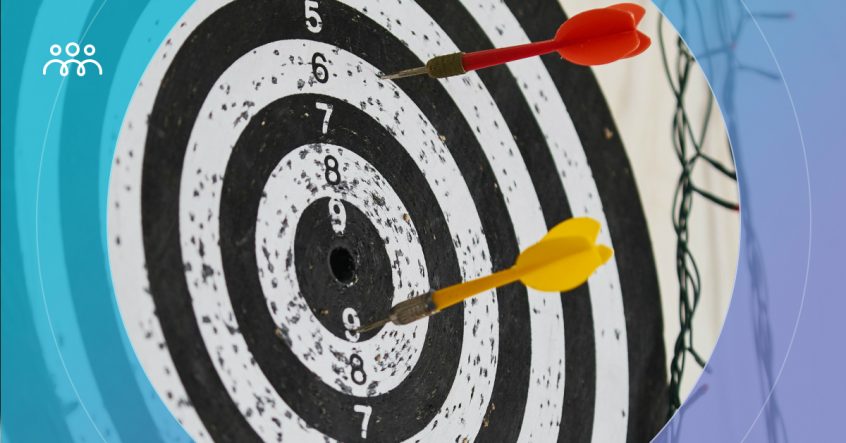Have you been using the Facebook Relevance Score to measure ad quality? Because here’s what you should know: Facebook has killed relevance score on April 30 and replaced it with three new metrics, namely…
- Quality ranking
- Engagement rate ranking
- Conversion rate ranking
Overall, these metrics are called Ad Relevance Diagnostics. You may be wondering, “Why the replacement?” Here’s a simple answer:
Facebook aims to improve your advertising campaigns. Facebook says, “We’re constantly evolving our ad platform, which means that our metrics must evolve, too.”
Before we dive deeper into the new Ad Relevance Diagnostics, let’s do a brief recap on the Facebook Relevance Score and what it was about.
What Was the Facebook Relevance Score?
Facebook relevance score is a metric at the ad level that tells you how relevant your ad is to your target audience. Facebook assigns your ad a score from 1-10 after it generates more than 500 impressions.
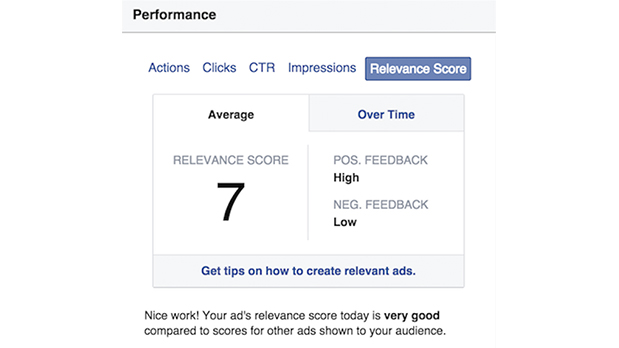
A score of 1 means that your ad is irrelevant, while 10 means that your ad is highly relevant.
Here’s what happens if you get a low relevance score: Facebook charges you more and lowers the reach of your ad. This compels business owners and marketers to stop running their ads that are low in quality.
So how does Facebook determine the relevance score? The relevance score was calculated based on the positive and negative feedback it receives from its target audience. For example, if people hide or report your ad more often, your relevance score will be lower.
The Problem with Facebook Relevance Score
If relevance score seems like a useful metric, why did it go away?
As it turns out, relevance score didn’t offer much help. For example, if you received a score of 4 out of 10, you can’t really tell why you got that score and the specific improvements you need to make.
Facebook Ad Relevance Diagnostics: What You Should Know
To increase your understanding of your ad performance, Facebook has shifted from relevance score to relevance diagnostics.
As previously mentioned, these diagnostics include quality ranking, engagement ranking, and conversion rate ranking. Each diagnostic will either receive a rating of below average, average, or above average.
Now, where to find ad relevance diagnostics?
Go to your Ads Manager and choose the campaign you want to look into. Next, select the ad set that contains the ads you’re going to examine.
(Important: Like the relevance score, the relevance diagnostics metric is found at the ad level – not the campaign or ad set level.)

At the ad level, scroll to the right to see the columns for Quality Ranking, Engagement Rate Ranking, and Conversion Rate Ranking:
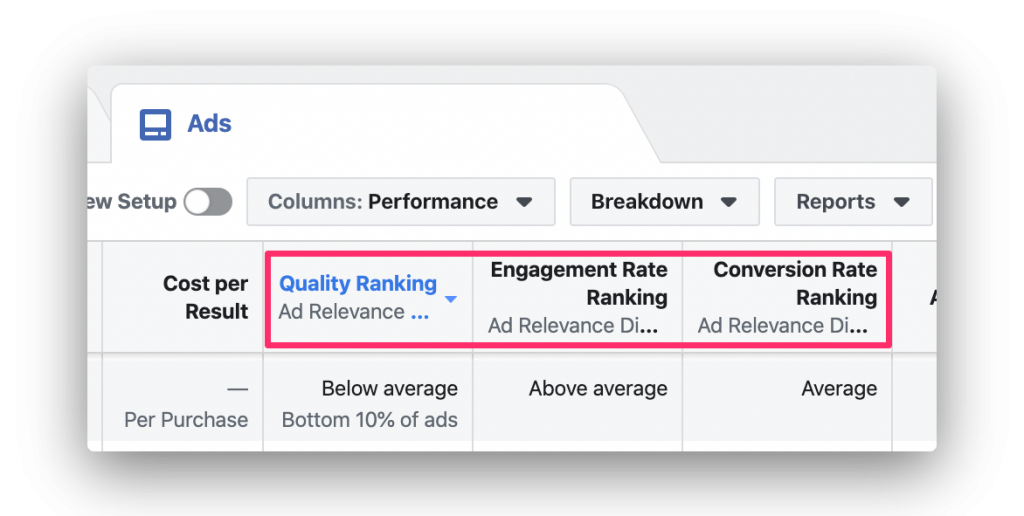
You need to get more than 500 impressions in order to get a ranking for each diagnostic.
Moving forward, let’s find out what each diagnostic means:
Quality Ranking
Quality ranking measures your ad’s perceived quality in comparison with other ads that target the same audience.
Let’s say that your ad received a rank of below average. It could be that people find your ad as a form of clickbait or that your ad gave them a poor experience. Maybe your headline was boring, exaggerated, or didn’t fulfill its promise on the landing page.
(Here’s more information about Quality Ranking)
Engagement Rate Ranking
Engagement rate ranking measures your ad’s expected engagement compared to ads that compete for the same audience. If you’re not sure what engagement means, it refers to the clicks, reactions, comments, and shares that your ad receives.
(Read more about Engagement Rate Ranking)
Conversion Rate Ranking
Conversion Rate Ranking measures your ad’s expected conversion rate compared to ads with the same optimization goal and that compete for the same audience.
If you want to improve this diagnostic, you’ll need to pay attention to people’s experiences after clicking on your ad.
Are they asked to complete many form fields? Does your landing page load slowly or does it have bad copy? Are you targeting an audience that’s less likely to purchase your product?
(Here’s more information on Conversion Rate Ranking)
Bottom Line: Relevance diagnostics gives advertisers more insight into their campaign performance. That way, you’re able to know which areas of your campaign need improving.
How to Use Ad Relevance Diagnostics
It’s obvious below average rankings should be moved up. But what about average rankings? Should you stress about them? Here’s what Facebook says:
“It’s more impactful to move a ranking from low to average than it is to move a ranking from average to above average, so focus on improving low rankings rather than on improving average rankings.”
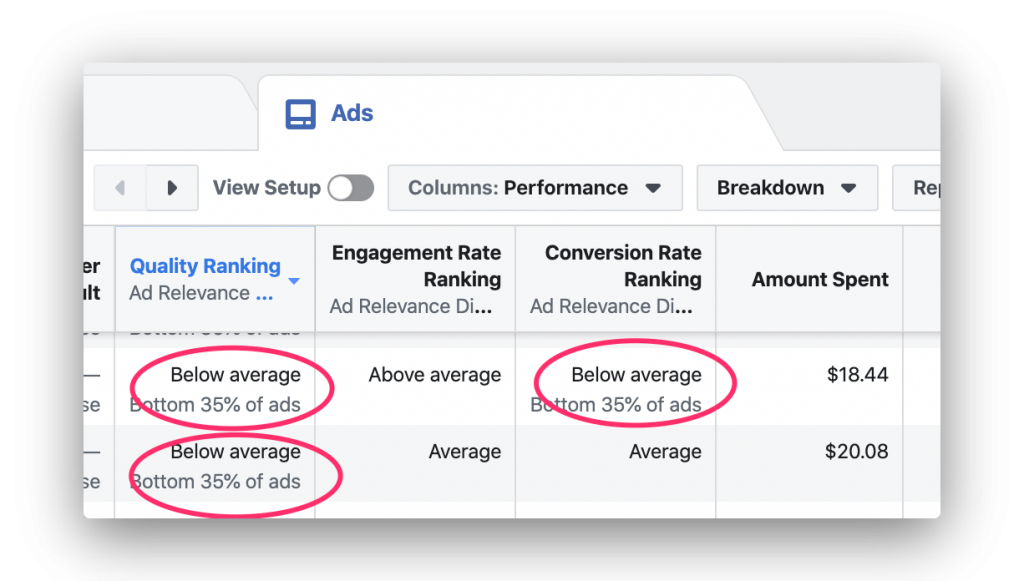
Facebook also provides a useful chart that lists all possible relevance diagnostics results, their causes, and what you can do to improve them. See the screenshot below:
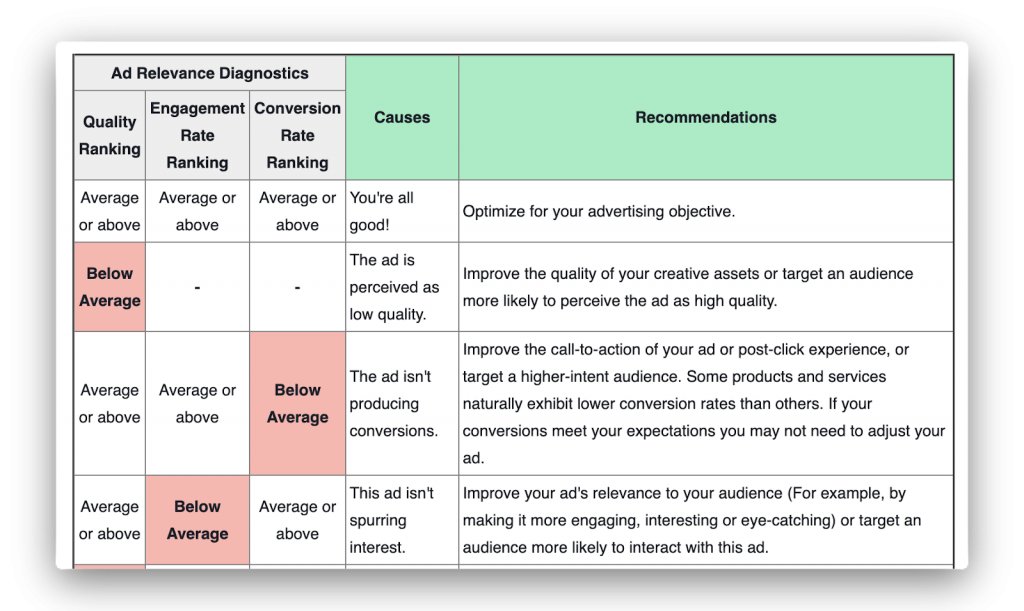
Access the complete chart by clicking here.
3 Ways to Improve Your Facebook Ads
If any of your diagnostics fall below average, it means that your competitors are running better ads than you.
Here are tips to make sure that your ads resonate with your audience and get them to engage and convert.
1. Get your audience targeting right.
Targeting can make or break your Facebook ad campaign. It’s impossible to create relevant advertisements if you have little idea about your audience.
Where do they live? How old are they? What are their interests? Are they known to buy what you’re offering?
One of the things you can do (aside from market research) to understand your audience and improve targeting is to use the Audience Insights tool. It’ll enable you to analyze everyone on Facebook or people connected to your Facebook page.

2. Write good Facebook ad copy.
It’s much easier to entice and engage your audience with your copy once you understand them. According to Facebook, writing ad copy is both art and science.
Here are a few simple tweaks you can make to write better Facebook ads:
2.1. Consider the right stage of the sales funnel.
Some people are ready to buy your offer, while others are still in the learning phase – they need more information.
For example, if you’re targeting people at the top of your sales funnel, it won’t make sense to create copy that invites them to buy.
Here’s an example of an ad where I write copy that speaks directly to those who’ve watched my training and are ready to take one step further by using ConnectExplore:
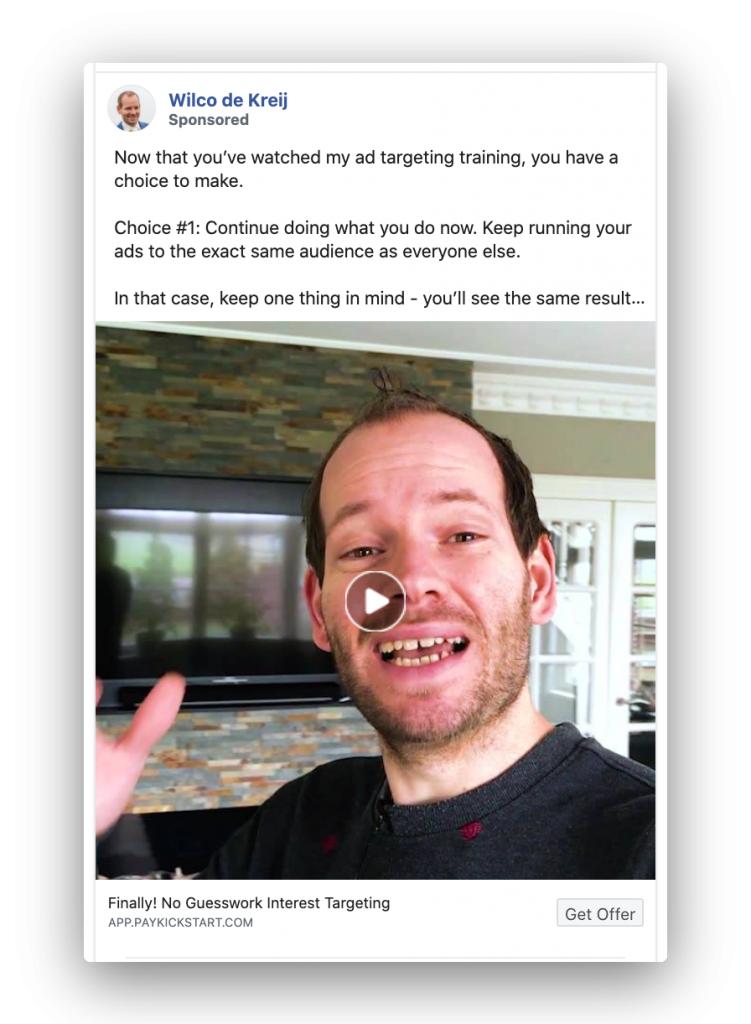
2.2 Tie your copy to your visual.
If you’re promoting food, the best photo that goes with your copy would be food – not a plain image of your logo. Your copy should relate to your visuals, and vice versa.
2.3. Write a compelling headline.
With the limited number of characters you have, it’s important to get your message across quickly. At the same time, make your headline attractive.
Start your ad headline with numbers. Use emotional words. Don’t mislead your audience!
Bonus: Get our FREE tool to write your Facebook Ads
3. Optimize the post-click experience on your landing page.
A post-click landing page refers to a page that people arrive on after visiting your Facebook ad. Here’s why the post-click experience matters:
Facebook users may love your ad and click on it. But if they find irrelevant content or don’t get any value on your landing page, they have no reason to convert.
You want to make sure that your landing page has the same look and feel like your Facebook ad. Your landing page headline should also be similar to what’s on your ad. Keep it clear and concise.
When it comes to your contact form, minimize the number of your form fields. The more information you require from your audience, the less likely they are to fill out your form.
Final Thoughts
Facebook relevance score has gone away and has been replaced by relevance diagnostics. Relevance diagnostics gives you a more granular look at the performance of your ads. Facebook keeps on updating and refining its metrics to help advertisers get better results!
Speaking of better results, Connectio provides tools that enable you to run more targeted Facebook ads in a time-saving and efficient manner. Check out Connectio today! ?

